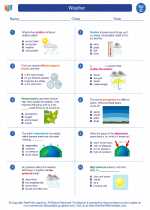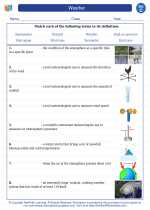Photosynthesis
Photosynthesis is the process by which green plants, algae, and some bacteria convert light energy, water, and carbon dioxide into glucose (a type of sugar) and oxygen. This process is essential for life on Earth, as it provides the energy and oxygen necessary for the survival of many organisms.
Key Concepts
- Chlorophyll: This is the green pigment found in the chloroplasts of plant cells. It is responsible for capturing light energy during photosynthesis.
- Light-dependent reactions: These are the initial stages of photosynthesis that require light to produce energy-rich compounds such as ATP and NADPH.
- Calvin cycle: This is the second stage of photosynthesis, which uses the energy produced in the light-dependent reactions to convert carbon dioxide into glucose.
- Factors affecting photosynthesis: Light intensity, carbon dioxide concentration, and temperature can all impact the rate of photosynthesis.
Study Guide
When studying photosynthesis, it's important to understand the following key points:
- What is the overall chemical equation for photosynthesis?
- What are the two main stages of photosynthesis, and what happens during each stage?
- How does chlorophyll capture light energy, and what happens to this energy during the light-dependent reactions?
- What factors can affect the rate of photosynthesis, and how do they impact the process?
- What is the role of glucose in the overall function of a plant?
By understanding these key concepts and studying the process of photosynthesis, you will gain a deeper appreciation for the importance of this biological process in sustaining life on Earth.
.◂Science Worksheets and Study Guides Third Grade. Weather
Study Guide Weather
Weather  Worksheet/Answer key
Worksheet/Answer key Weather
Weather  Worksheet/Answer key
Worksheet/Answer key Weather
Weather  Worksheet/Answer key
Worksheet/Answer key Weather
Weather  Vocabulary/Answer key
Vocabulary/Answer key Weather
Weather  Vocabulary/Answer key
Vocabulary/Answer key Weather
Weather 

 Worksheet/Answer key
Worksheet/Answer key
 Worksheet/Answer key
Worksheet/Answer key
 Worksheet/Answer key
Worksheet/Answer key
 Vocabulary/Answer key
Vocabulary/Answer key
 Vocabulary/Answer key
Vocabulary/Answer key

The resources above cover the following skills:
EARTH AND SPACE SCIENCE (NGSS)
Earth’s Systems
Students who demonstrate understanding can:
Represent data in tables and graphical displays to describe typical weather conditions expected during a particular season.